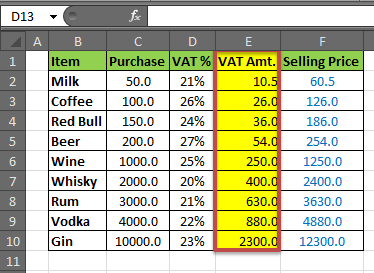Value Added Tax, often referred to as Value Added Tax, is often perceived as a complicated puzzle for companies. Due to varying rates, exempted categories, and the ongoing changes in regulations, understanding Value Added Tax is crucial for maintaining compliance and ensuring financial health. Whether you are a small startup or an long-standing corporation, knowing how to precisely calculate VAT can significantly impact your financial outcome.
Every organization needs to stay informed about their numbers, particularly as they pertain to VAT. Errors can lead to costly penalties, cash flow issues, and even damage to a company's image. Using a VAT calculator can simplify this process, aiding businesses to efficiently determine their tax obligations and steer clear of the pitfalls that come with Value Added Tax miscalculations. Grasping VAT is not just about adhering to the rules; it is about gaining a market advantage in a landscape where every decimal counts.

Comprehending Value Added Tax Fundamentals
VAT, or VAT, is a sales tax levied on the additional value to goods and services at each stage of manufacturing or delivery. Companies are required to gather VAT from customers on behalf of the government, which makes essential for every business to comprehend how this tax functions. VAT is typically expressed as a percentage of the selling price, and various countries may have varying rates and regulations, leading to thorough knowledge important.
Determining VAT precisely is vital for compliance to prevent potential penalties. Businesses need to identify both the VAT they withhold from customers and the VAT they pay on their acquisitions. This entails comprehending the difference between tax collected on sales, which is the VAT collected on transactions, and input tax, which is the VAT remitted on acquisitions. Using a tax calculator can ease this process, helping businesses to efficiently track their VAT obligations and ensure that they declare the accurate amounts.
Understanding the subtleties of VAT can also offer strategic benefits. For instance, companies that can efficiently manage their VAT responsibilities may boost cash flow and optimize pricing strategies. Knowledge of existing VAT exceptions or reduced rates can result in significant savings. Consequently, gaining a deep understanding of VAT expertise is more than adherence; it can also be an means for enhancing financial performance.
The Value of Accurate Computation
Precise VAT computations are essential for companies of every size. A small error in calculating VAT can lead to substantial monetary consequences, including sanctions from revenue services, decline of trust, and potential liquidity problems. Guaranteeing that VAT is computed correctly helps companies remain compliant with tax regulations while also shielding their financial health.
Using a VAT calculating tool can considerably make easier the process of establishing VAT totals. These tools take the uncertainty out of computations, making it easier for companies to verify they are gathering the correct total of VAT from their clients. A trustworthy VAT calculator can lower inaccuracies and simplify the financial process, liberating valuable time and means for businesses to devote themselves to growth and other important activities.
In addition, knowing the correct amount of VAT owed enables better fiscal planning and financial oversight. When organizations know their VAT responsibilities, they can oversee their liquidity more efficiently, making sure they have the required resources set aside for tax payments. This foresight helps stop surprising financial strain and facilitates better strategic allocations decisions, finally leading to a more resilient & more resilient business.
Employing a VAT Calculator Efficiently
Employing a VAT calculator can greatly enhance the process of determining your business's VAT responsibilities. By entering your sales and purchase data, the tool quickly computes how much Value Added Tax you are liable for or can reclaim. calculate vat ireland conserves time but also reduces the risk of human error that can occur when doing calculations manually. To make the most of a Value Added Tax calculator, ensure that you have all relevant figures at hand and double-check your entries for correctness.
Moreover, it is essential to remain updated with the current VAT rates and laws, as these can shift and impact your calculations. Many VAT tools are designed to handle these changes automatically, making it easier for companies to remain compliant. Frequently reviewing your VAT results helps ensure that you are charging the right sum to customers and recovering the right amount on your purchases, facilitating a seamless tax process.
Finally, integrating a Value Added Tax tool into your financial systems can provide visibility into your financial flow and overall economic status. Having these insights at your disposal allows you to make smart business decisions while managing your Value Added Tax efficiently. The sooner you adapt to using a VAT calculator, the better you can navigate the complexities of VAT and keep your business on the right track.
